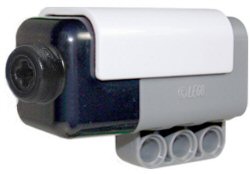This is an old revision of the document!
Table of Contents
LabVIEW and Hitechnic Angle Sensor
Author: Yu Hang He Email: hey6@unlv.nevada.edu
Date: Last modified on <08/21/17>
Keywords: LabVIEW, NXT, Hitechnic Angle Sensor

The photo above depicts Hitechnic NXT Angle Sensor which allows you to measure axle rotational position and rotation speed. The Angle Sensor enables you to measure absolute angle, accumulated angle, and rotational speed. This tutorial shows you how to use LabVIEW to program Hitechnic NXT Angle Sensor and display the result on front panel and takes approximately 2 hours to complete.
Motivation and Audience
This tutorial's motivation is to demonstrate how to program Hitechnic NXT Angle Sensor with LabVIEW. This tutorial assumes the reader has the following background and interests:
* Know how to <fill in the blank>
* Perhaps also know how to <fill in the blank>
* Perhaps additional background needed may include <fill in the blank>
* This tutorial may also attract readers who <fill in the blank>
The rest of this tutorial is presented as follows:
- Programming <!- delete this line if not applicable →
- Final Words
Parts List and Sources
US-based vendors to obtain material to complete this tutorial include <list relevant hyperlinks or phone numbers and addresses>.
To complete this tutorial, you'll need the following items
| PART NAME/DESCRIPTION | VENDOR | VENDOR Number or URL | PRICE | QTY |
|---|---|---|---|---|
| Smooth-on Silicone Mold Rubber | Amazon.com | http://www.amazon.com/Smooth-Silicone-Making-Rubber-Inc/dp/B004BNF3TK | $23.86 | 1 |
| <???> d | <???> | <???> | <???> | <???> |
| <???> d | <???> | <???> | <???> | <???> |
| <???> d | <???> | <???> | <???> | <???> |
| <???> d | <???> | <???> | <???> | <???> |
Here is the list as a Google XLS document
Here is the list as a PDF file
Construction
This section gives step-by-step instructions along with photos to <fill in the blank>. (If a circuit-building tutorial:) A schematic to construct <fill in the blank> is shown here <add image>. <Add hyperlink to PDF of schematic> is the Acrobat file of the same schematic.
Step 1
<Add photos to make step easier to understand>
Step 2
<Additional steps like Step 3, Step 4, etc>
Programming
A link to the source code can be found <provide URL to your code, probably saved in this DASL Wiki>.
The goal of the code is <brief explanation>. It works in the following way
<!- Insert a snippet of your code here. Try to keep to less than 0.5 page long –>
The snippet above serves to <fill in the blank>. It does this by <fill in the blank>.
<!- Insert another snippet of your code here. Try to keep to less than 0.5 page long –>
Next, the code does <fill in the blank>. It does this by <fill in the blank>.
Final Words
This tutorial's objective was to <fill in the blank>. Complete <choose: construction details, source code and program descriptions> for <fill in the blank>. Once the concepts were conveyed the reader could <fill in the blank>.
Speculating future work derived from this tutorial, includes <fill in the blank>. In the big picture, the problem of <fill in the blank> can be solved with this tutorial.
For questions, clarifications, etc, Email: paul.oh@unlv.edu
